
|
Astronomy Picture Of the Day (APOD)
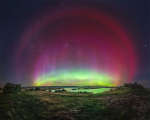 APOD: 2024 January 3 B A SAR Arc from New Zealand
APOD: 2024 January 3 B A SAR Arc from New Zealand
3.01.2024
What is that unusual red halo surrounding this aurora? It is a Stable Auroral Red (SAR) arc. SAR arcs are rare and have only been acknowledged and studied since 1954. The featured wide-angle photograph...
 APOD: 2024 January 2 B Rocket Transits Rippling Moon
APOD: 2024 January 2 B Rocket Transits Rippling Moon
2.01.2024
Can a rocket make the Moon ripple? No, but it can make a background moon appear wavy. The rocket, in this case, was a SpaceX Falcon Heavy that blasted off from NASA's Kennedy Space Center last week.
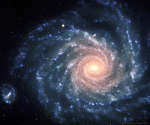 APOD: 2024 January 1 B NGC 1232: A Grand Design Spiral Galaxy
APOD: 2024 January 1 B NGC 1232: A Grand Design Spiral Galaxy
1.01.2024
Galaxies are fascinating not only for what is visible, but for what is invisible. Grand spiral galaxy NGC 1232, captured in detail by one of the Very Large Telescopes, is a good example.
 APOD: 2023 December 31 B Illustris: A Simulation of the Universe
APOD: 2023 December 31 B Illustris: A Simulation of the Universe
31.12.2023
How did we get here? Click play, sit back, and watch. A computer simulation of the evolution of the universe provides insight into how galaxies formed and perspectives into humanity's place in the universe.
 The Last Full Moon
The Last Full Moon
30.12.2023
Known to some in the northern hemisphere as December's Cold Moon or the Long Night Moon, the last full moon of 2023 is rising in this surreal mountain and skyscape. The Daliesque scene was captured in a single exposure with a camera and long telephoto lens near Monte Grappa, Italy.
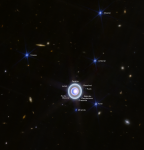 Shakespeare in Space
Shakespeare in Space
29.12.2023
In 1986, Voyager 2 became the only spacecraft to explore ice giant planet Uranus close up. Still, this newly released image from the NIRCam (Near-Infrared Camera) on the James Webb Space Telescope offers a detailed look at the distant world. The tilted outer planet rotates on its axis once in about 17 hours.
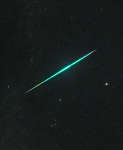 Jupiter and the Geminid
Jupiter and the Geminid
28.12.2023
For a brief moment, this brilliant fireball meteor outshone Jupiter in planet Earth's night. The serendipitous image was captured while hunting meteors under cold Canadian skies with a camera in timelapse mode on December 14, near the peak of the Geminid meteor shower.
 APOD: 2023 December 27 B Rainbow Aurora over Icelandic Waterfall
APOD: 2023 December 27 B Rainbow Aurora over Icelandic Waterfall
27.12.2023
Yes, but can your aurora do this? First, yes, auroras can look like rainbows even though they are completely different phenomena. Auroras are caused by Sun-created particles being channeled into Earth's atmosphere by Earth's magnetic field, and create colors by exciting atoms at different heights.
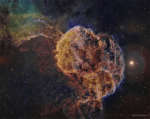 APOD: 2023 December 26 B IC 443: The Jellyfish Nebula
APOD: 2023 December 26 B IC 443: The Jellyfish Nebula
26.12.2023
Why is this jellyfish swimming in a sea of stars? Drifting near bright star Eta Geminorum, seen at the right, the Jellyfish Nebula extends its tentacles from the bright arcing ridge of emission left of center.
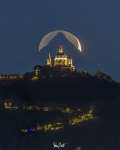 APOD: 2023 December 25 B Cathedral, Mountain, Moon
APOD: 2023 December 25 B Cathedral, Mountain, Moon
25.12.2023
Single shots like this require planning. The first step is to realize that such an amazing triple-alignment actually takes place. The second step is to find the best location to photograph it. But it was the third step: being there at exactly the right time -- and when the sky was clear -- that was the hardest.
|
January February March April May June |
|||||||||||||||||||||||||||||||||||||||||||||||||